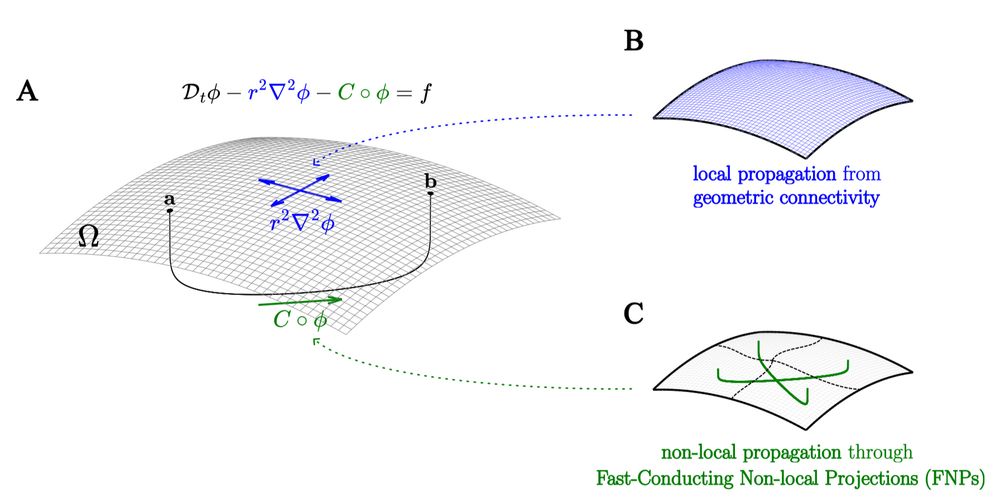
We develop time series tools & physical models to understand the dynamics of complex (usually neural) systems.
Also: @bendfulcher@fediscience.org
We introduce an efficient set of statistical features for fMRI time series (calibrated on mouse manipulation experiments and tested on mouse and human data): catchaMouse16.
Paper: doi.org/10.52294/001...
Code (python/Matlab/C): github.com/DynamicsAndN...

We introduce an efficient set of statistical features for fMRI time series (calibrated on mouse manipulation experiments and tested on mouse and human data): catchaMouse16.
Paper: doi.org/10.52294/001...
Code (python/Matlab/C): github.com/DynamicsAndN...
This might help explain why we see stronger non-local dynamics in targeted stimulation experiments.

This might help explain why we see stronger non-local dynamics in targeted stimulation experiments.
The role of long-range connections in shaping dynamics is heavily timescale dependent, concentrated on fast dynamics <~ 30 ms, while slow dynamics resemble the geometric model. This could help explain why they are less important for capturing slower rs-fMRI dynamics.

The role of long-range connections in shaping dynamics is heavily timescale dependent, concentrated on fast dynamics <~ 30 ms, while slow dynamics resemble the geometric model. This could help explain why they are less important for capturing slower rs-fMRI dynamics.
The model dynamics combine wave propagation with 'worm-hole' shortcuts 🕳️🐛

The model dynamics combine wave propagation with 'worm-hole' shortcuts 🕳️🐛


Why are long-range connectomic interactions in the cortex dominant in shaping dynamics in some experiments but apparently negligible in others?
We (w/ R Maran, @elimuller.bsky.social) address this question by studying a new hybrid model of cortical dynamics.
arxiv.org/abs/2506.19800

Why are long-range connectomic interactions in the cortex dominant in shaping dynamics in some experiments but apparently negligible in others?
We (w/ R Maran, @elimuller.bsky.social) address this question by studying a new hybrid model of cortical dynamics.
arxiv.org/abs/2506.19800



arxiv.org/abs/2412.15826
Quick summary below 👇

arxiv.org/abs/2412.15826
Quick summary below 👇
"Analyzing the Brain's Dynamic Response to Targeted Stimulation using Generative Modeling"
A review/perspective on why new mechanisms may be found by modeling brain stimulation dynamics 🧠⚡️
arxiv.org/abs/2407.19737

"Analyzing the Brain's Dynamic Response to Targeted Stimulation using Generative Modeling"
A review/perspective on why new mechanisms may be found by modeling brain stimulation dynamics 🧠⚡️
arxiv.org/abs/2407.19737
biorxiv.org/content/10.1...
We found a reduced set of time-series features relevant to fMRI (trained in mouse).
Code: github.com/DynamicsAndN...

biorxiv.org/content/10.1...
We found a reduced set of time-series features relevant to fMRI (trained in mouse).
Code: github.com/DynamicsAndN...
We unify a previously disjoint literature on algorithms for this important problem and introduce new benchmarking results.
arxiv.org/abs/2407.089...
#timeseriesanalysis #complexsystems

We unify a previously disjoint literature on algorithms for this important problem and introduce new benchmarking results.
arxiv.org/abs/2407.089...
#timeseriesanalysis #complexsystems
—'Transdiagnostic Perspectives on Neurodevelopmental and Psychiatric Disorders - Part 1' 12pm oral session (Tue)
—Poster #1740 (Wed/Thurs)
www.biorxiv.org/content/10.1...

—'Transdiagnostic Perspectives on Neurodevelopmental and Psychiatric Disorders - Part 1' 12pm oral session (Tue)
—Poster #1740 (Wed/Thurs)
www.biorxiv.org/content/10.1...
www.biorxiv.org/content/10.1...

www.biorxiv.org/content/10.1...
"Tracking the distance to criticality in systems with unknown noise"
By Brendan Harris, w/ Leonardo Gollo.
We identify new, noise-robust time-series features for tracking the distance to criticality
Paper: arxiv.org/abs/2310.14791
Code: github.com/brendanjohnh...
#ComplexSystems


"Tracking the distance to criticality in systems with unknown noise"
By Brendan Harris, w/ Leonardo Gollo.
We identify new, noise-robust time-series features for tracking the distance to criticality
Paper: arxiv.org/abs/2310.14791
Code: github.com/brendanjohnh...
#ComplexSystems
@elife.bsky.social
elifesciences.org/articles/78620

@elife.bsky.social
elifesciences.org/articles/78620
Fast time-series feature-extraction in C, python, Julia, R, and Matlab.
github.com/DynamicsAndN...

Fast time-series feature-extraction in C, python, Julia, R, and Matlab.
github.com/DynamicsAndN...



